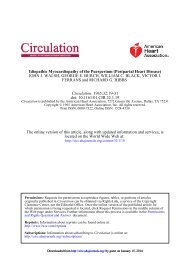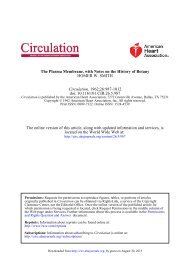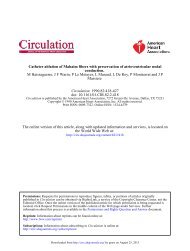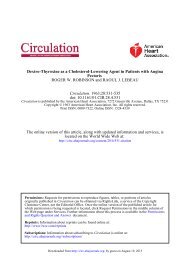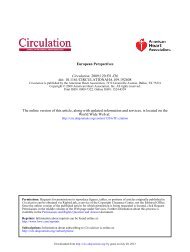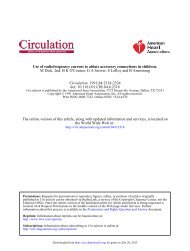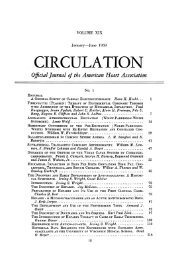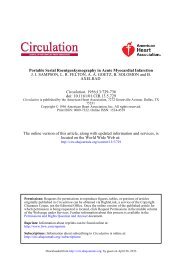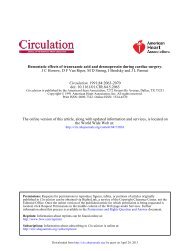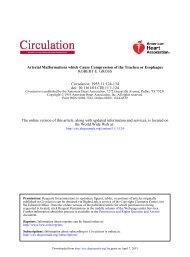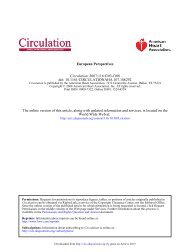Anomalous Pulmonary Venous Return - Circulation
Anomalous Pulmonary Venous Return - Circulation
Anomalous Pulmonary Venous Return - Circulation
Create successful ePaper yourself
Turn your PDF publications into a flip-book with our unique Google optimized e-Paper software.
<strong>Anomalous</strong> <strong>Pulmonary</strong> <strong>Venous</strong> <strong>Return</strong><br />
HU A. BLAKE, COL., ROBERT J. HALL, LT. COL. and WILLIAM C. MANION<br />
<strong>Circulation</strong>. 1965;32:406-414<br />
doi: 10.1161/01.CIR.32.3.406<br />
<strong>Circulation</strong> is published by the American Heart Association, 7272 Greenville Avenue, Dallas, TX 75231<br />
Copyright © 1965 American Heart Association, Inc. All rights reserved.<br />
Print ISSN: 0009-7322. Online ISSN: 1524-4539<br />
The online version of this article, along with updated information and services, is<br />
located on the World Wide Web at:<br />
http://circ.ahajournals.org/content/32/3/406<br />
Permissions: Requests for permissions to reproduce figures, tables, or portions of articles<br />
originally published in <strong>Circulation</strong> can be obtained via RightsLink, a service of the Copyright<br />
Clearance Center, not the Editorial Office. Once the online version of the published article for<br />
which permission is being requested is located, click Request Permissions in the middle column of<br />
the Web page under Services. Further information about this process is available in the Permissions<br />
and Rights Question and Answer document.<br />
Reprints: Information about reprints can be found online at:<br />
http://www.lww.com/reprints<br />
Subscriptions: Information about subscribing to <strong>Circulation</strong> is online at:<br />
http://circ.ahajournals.org//subscriptions/<br />
Downloaded from<br />
http://circ.ahajournals.org/ by guest on May 16, 2013
<strong>Anomalous</strong> <strong>Pulmonary</strong> <strong>Venous</strong> <strong>Return</strong><br />
By Hu A. BLAKE, COL., MC, ROBERT J. HALL, LT. COL., MC,<br />
AND WILLIAM C. MANION, M.D.<br />
M ANY detailed studies concerning isolated<br />
aspects of anomalous pulmonary<br />
venous return are available. Surveys encompassing<br />
the entire spectrum of such anomalies<br />
are, however, generally lacking. For purposes<br />
of this presentation, 113 selected instances of<br />
anomalous pulmonary venous return encountered<br />
at Brooke General Hospital, Walter<br />
Reed General Hospital, and the Registry of<br />
Cardiovascular Pathology of the Armed<br />
Forces Institute of Pathology have been reviewed<br />
and correlated with related material<br />
from the literature. To obtain completeness,<br />
tempered with brevity, the better known<br />
anomalies, while mentioned, are discussed<br />
only briefly, whereas the less well described<br />
transitional forms are discussed in detail.<br />
Highly schematic diagrams are used to portray<br />
some 27 variations in this theme. It is<br />
hoped the wide anatomic spectrum shown<br />
will promote understanding and interest.<br />
Figure IA illustrates the most frequently<br />
described variety of anomalous pulmonary<br />
venous return in which all or a part of the<br />
veins from the right lung drain directly into<br />
the right atrium. In two of 26 such instances<br />
the septum interestingly was intact. It should<br />
be emphasized that a normal connection does<br />
not always mean normal drainage. We, like<br />
others, have seen examples in which indicatordilution<br />
curves indicated normal drainage and<br />
at surgery the vein connected anomalously." 2<br />
Figure iB, a situation encountered twice,<br />
we think important as it represents a paradox<br />
not easily explainable embryologically. Entry<br />
of the right pulmonary veins into the left<br />
atrium and entry of the left pulmonary veins<br />
into the right atrium seemingly defy ex-<br />
From Brooke General Hospital, Fort Sam Houston,<br />
Texas; Walter Reed General Hospital, Washington;<br />
and the Registry of Cardiovascular Pathology, Armed<br />
Forces Institute of Pathology, Washington, D. C.<br />
406<br />
planation on the basis of simple reabsorption<br />
of the common pulmonary vein followed<br />
by abnormal septation. We are not familiar<br />
with others encountering this anomaly.<br />
Eight instances of total anomalous pulmonary<br />
venous return to the right atrium<br />
(fig. IC) were seen. When there was a large<br />
defect lacking a septal ridge posteriorly, it<br />
was often difficult spatially to orient the<br />
venous orifices. The incidence of this anomaly<br />
might have been increased, if one had been<br />
less critical in this regard.<br />
Figure ID differs only in the addition of a<br />
left superior vena cava. The emptying of this<br />
vessel into the coronary sinus distinguishes<br />
it from a persistent left innominate vein.3<br />
Figure IE is a case associated with four<br />
venae cavae. The flow through the persistent<br />
left inferior vena cava usually represents hepatic<br />
vein drainage. This is one of two cases<br />
we have personally encountered with all four<br />
venae cavae persisting. (See also figure 6,<br />
where there are two inferior venae cavae.)<br />
We have observed seven methods whereby<br />
anomalous pulmonary venous return has occurred<br />
at the supracardiac level. These were<br />
(1) partial or (2) complete anomalous pulmonary<br />
venous return directly into the right<br />
superior vena cava, (3) partial return from<br />
the right through the azygos vein, (4) partial<br />
from both lungs through the azygos vein, (5)<br />
partial return via a left innominate vein, (6)<br />
complete return via a left innominate vein,<br />
and (7) partial return from both lungs via a<br />
levo-atrial cardinal vein to the right superior<br />
vena cava. In the interest of continuity, four<br />
of these seven variations will be covered now<br />
with discussion of the remaining three<br />
more appropriately being placed later.<br />
Figure IF depicts the findings in twenty<br />
cases of partial or total right pulmonary<br />
venous return into the right superior vena<br />
cava. Embryologically, these defects are often<br />
Downloaded from<br />
http://circ.ahajournals.org/ by guest on May 16, 2013<br />
<strong>Circulation</strong>, Volume XXXII, September 1965
ANOMALOUS PULMONARY VENOUS RETURN<br />
Figure 1<br />
Schematic representation of types of anomalous venous return.<br />
associated with high, sinus venosus-type atrial<br />
septal defects.4 5 Such high defects were observed<br />
in 17 instances, typical secundum defects<br />
occurred twice, and in one instance the<br />
atrial septum was intact.<br />
All pulmonary veins entering the right<br />
superior vena cava to date have done so at<br />
or below the azygos entry. This finding is<br />
interesting in view of the frequency of anomalous<br />
pulmonary venous return on the left<br />
finding its way to the left jugular-subclavian<br />
juncture. Higher, more peripheral connections<br />
suspected on catheterization, but not proved<br />
at surgery, are explained by the perfused<br />
unexercised right arm giving unusually high<br />
<strong>Circulation</strong>, Volume XXXII, September 1965<br />
407<br />
oxygen-saturation values. Entry at or below<br />
the azygos level enhances surgical repair.<br />
Complete anomalous pulmonary venous return<br />
to the right superior vena cava, found<br />
seven times, is depicted in figure 1G. In this<br />
small group, three anatomic features were<br />
apparent. First, the lowermost end of the<br />
cava was consistently dilated. Secondly, the<br />
anomalous orifice was usually quite large,<br />
placed directly posterior, and single. Thirdly,<br />
the accompanying septal defect was highly<br />
placed. These factors again favor surgical<br />
repair.<br />
<strong>Anomalous</strong> pulmonary venous return<br />
through the azygos vein may exist in part or<br />
Downloaded from<br />
http://circ.ahajournals.org/ by guest on May 16, 2013
408<br />
in whole. Figure IH depicts partial return of<br />
all the right pulmonary veins to the right<br />
superior vena cava through the azygos. One<br />
might also suspect an absence of the suprarenal<br />
portion of the inferior vena cava to accompany<br />
this defect.Y This was not true in this<br />
case.<br />
Total anomalous pulmonary venous return<br />
to the superior vena cava through the azygos<br />
and persistent left innominate veins was seen<br />
but once and is depicted in figure 1I. The<br />
term persistent left innominate vein is preferable<br />
to persistent left superior vena cava when<br />
this remnant of the left anterior cardinal vein<br />
fails to maintain a connection with the coronary<br />
sinus or left atrium.<br />
With these four descriptions completed, the<br />
three remaining variations of anomalous pulmonary<br />
venous return to the right superior<br />
vena cava will be inserted at points considered<br />
more advantageous in regard to continuity.<br />
Low cardiac and immediately infracardiac<br />
connections are the next two groups to be<br />
considered. In these categories, five interesting<br />
and often extremely complex connections<br />
were encountered. These were (1) partial to<br />
the inferior vena cava, (2) partial and (3)<br />
complete to the coronary sinus, and (4)<br />
partial and (5) complete to the portal<br />
system.<br />
First discussed are partial connections<br />
from the right lung to the inferior vena cava.<br />
The seven instances encountered have proved<br />
interesting in that they are somewhat in<br />
variance with published data. In five of them,<br />
there was an associated atrial septal defect,<br />
in two there were none. Additionally, both<br />
supradiaphragmatic and infradiaphragmatic<br />
inferior vena cava connections were seen. The<br />
anatomic configuration of these channels has<br />
been studied in detail, as correction usually<br />
entails transplantation to a higher level. In<br />
two of the four cases suitable for study, approximately<br />
one third of the circumference of<br />
the anomalous channel was visible superficially<br />
as it lay grooving the lung parenchyma.<br />
From the embedded portion of the circumference,<br />
small pulmonary venous branches<br />
serially joined the main trunk in a manner<br />
BLAKE ET AL.<br />
analogous to the coniferous branching of the<br />
spruce. In the remaining two cases, a large<br />
dichotomous branching took place immediately<br />
prior to this channel joining the inferior<br />
vena cava. This form of branching, as opposed<br />
to the smaller serially branching type,<br />
introduces the danger of a lower lobe venous<br />
infarction should either of these large limbs<br />
be divided to permit mobilization and higher<br />
reimplantation of the anomalously entering<br />
pulmonary vein.<br />
Figure 2A demonstrates the partial supradiaphragmatic<br />
drainage of the right lung<br />
into the inferior vena cava encountered six<br />
times. Drainage of blood from the left lung<br />
into the inferior vena cava is apparently rare.<br />
D'Cruz has reported a recent case.7 Interestingly,<br />
in our small group, only two cases<br />
demonstrated the features of the vena cavabronchovascular<br />
syndrome described by<br />
others.8-1 Likewise, the value of "commalike,"<br />
"sickle-shaped," "scimitar-shaped" paracardiac<br />
shadows in the lower right lung<br />
field as a pathognomonic indication of anomalous<br />
pulmonary venous return into the<br />
inferior vena cava should probably be deemphasized.<br />
Figure 3 shows such a paracardiac<br />
shadow, which though it was a long<br />
redundant pulmonary vein emptied normally<br />
into the left atrium.12 <strong>Pulmonary</strong> veins of<br />
this size with elongation, redundancy, and a<br />
normal left atrial point of entry probably best<br />
fit the category of "varicosities" of the pulmonary<br />
vein.13<br />
Figure 2B demonstrates the singly encountered<br />
partial drainage of the right lung<br />
into the inferior vena cava below the<br />
diaphragm. As the diaphragm was not opened<br />
at surgery, the anomalous pulmonary venous<br />
channel's course after piercing the<br />
central leaf of the diaphragm is obscure with<br />
but catheterization evidence of its high entry<br />
into the inferior vena cava. Cooke has described<br />
a somewhat similar case.14 Total infradiaphragmatic<br />
pulmonary venous connections to<br />
the inferior vena cava have been reported and<br />
twice successfully repaired.'5' 16 One should<br />
distinguish this form prognostically from<br />
infradiaphragmatic drainage into the portal<br />
Downloaded from<br />
http://circ.ahajournals.org/ by guest on May 16, 2013<br />
<strong>Circulation</strong>, Volume XXXII, September 1965
ANOMALOUS PULMONARY VENOUS RETURN<br />
Figure 2<br />
Schematic representation of types of anomalous pulmonary venous return-continued.<br />
system, as the physiologic disturbance produced<br />
by the latter is infinitely greater.<br />
Semantically representing low cardiac,<br />
rather than infracardiac drainage, anomalous<br />
return into the coronary sinus varies from one<br />
vein to that of all the veins returning by this<br />
route. Of the former, a single case, illustrated<br />
in figure 2C, was encountered. Bilateral lower<br />
lobe drainage into the coronary sinus has<br />
occurred.17 It should be noted that infrequently<br />
the coronary sinus fails to drain into the<br />
right atrium. In atresia of the orifice of the<br />
coronary sinus, the coronary sinus drains<br />
retrogradely into the left atrium through a<br />
persistent Bochdalek's foramen.1820 Figures<br />
<strong>Circulation</strong>, Volume XXXII, September 1965<br />
409<br />
4F and G later illustrate forms of this anomaly.<br />
Figure 2D represents a case of total coronary<br />
sinus drainage. The anatomic proximity of<br />
the enlarged orifice of the coronary sinus<br />
to the tricuspid valve presumably encourages<br />
streamlining of the coronary sinus-pulmonary<br />
venous return. This may result in<br />
the catheterization finding of higher oxygen<br />
saturations in the right ventricle and pulmonary<br />
artery than in the left atrium, left ventricle<br />
and the aorta, a point of diagnostic importance.<br />
Repair of such an anomaly is shown in<br />
figure 5. The narrow intervening bridge of<br />
tissue lying between the atrial septal defect<br />
Downloaded from<br />
http://circ.ahajournals.org/ by guest on May 16, 2013
410<br />
Figllre 3<br />
Arrows identify a vertically coursint, right paracardiac<br />
ptulmonary veffi. After a circaCtitons totc, this<br />
vein entered the lcft atritum iiormailh<br />
and the enlarged coronary siIIus orifice is excised<br />
and the two then confluent openings<br />
are roofed over diverting the pulmonary venouis<br />
and the coronary sinus return (the volume of<br />
the latter's desaturated blood is considered<br />
to be inconsequential) into the left atrium.<br />
Production of surgical heart block is to be<br />
avoided.21<br />
A variant of coronary sinus drainage is<br />
depicted in figure 2E. It has been inferred<br />
that mixed levels of anomalous pUlmonary<br />
venous drainage do not occur or are quite<br />
rare. Gott et al. reporting 30 cases of total<br />
anomalous pulmonary venous drainage stated,<br />
"Of the cases cited in the literature as having<br />
drainage via the left superior vena cava,<br />
none appears to drain in this fashion-communicating<br />
proximally with the coronary<br />
sinuis and distally with the innominate<br />
vein."22 Similarly, Darling's group in a review<br />
of 17 personal cases and a survey of<br />
the available literature (80 cases) could find<br />
but a single case of mixed levels of drainage.28<br />
Interestingly, nine instances of suich double<br />
0BLAKE ET AL.<br />
levels of drainage as illuistrated were encounitered<br />
in this series.<br />
In a single additional case, the left upper<br />
lobe vein drained normally inito the left<br />
atriu-m as shown in figu-re 2F.<br />
A transitional form leading tovards the<br />
classic "figure-of-eight" anomaly is illuistrated<br />
in figuire 2G. In this, and the followiing<br />
anomaly, the clinical anid radiologic patterni<br />
can apparently be inodified considerably,<br />
depending uipon xx hetlher or inot the perIsistent<br />
left eaval remnant passes as it uisuially does<br />
anterior to the puilmonary artery or posteriorly<br />
as is occasionally seen. In passing posterior<br />
to the pulmonary artery, the anomalous channiel<br />
may become obstructed with impeded<br />
venous ouitflow from the lulngs simullatinig an<br />
infradiaphragmatic type connection.24<br />
Figure 2H represenits the classic form of<br />
total anomalous puilmonary venouis return.<br />
Diagnostic-wise, xwide variatiois have occurred<br />
in the time of appearance of the<br />
classic chest roentgen ograin. The chest roentgenogram<br />
of a 3-montlh-old inifant xxas most<br />
suggestive, wvhereas in a 13-year-old the<br />
configuiration vas niot particuilarly impressive.<br />
The monotonouisly equlal, markedly elevated<br />
oxygen-saturations throughotut all chambers,<br />
pulmonary and peripheral arteries is highly<br />
suggestive of total anomalouis pulmonary vein<br />
drainage, especially of the supracardiac type.<br />
The values found in one such case are shown.<br />
Twvo associated anomalies have greatly<br />
inflicenced the cliinical courses followed by<br />
these patients. We have repaired suich anl<br />
anomaly in an older child in xvhich there<br />
was only the slightest clinical disability. This<br />
clinaical well-being apparently resulted from<br />
the coexistence of a mild pulmonary stenosis<br />
which beneficently prevented pLilmonary<br />
flooding and encoturaged right-to-left shunting<br />
through a large atrial septal defect. At<br />
the other extreme, marked early deterioration<br />
has been seen in quite young infants when<br />
the atrial commiunication was small, allowing<br />
little blood to reach the left side of the<br />
heart. In a 9'2 pound infant recently operated<br />
upon the diameter of this commniunication<br />
Downloaded from<br />
http://circ.ahajournals.org/ by guest on May 16, 2013<br />
Cic ulafton, Volume XXXI!, September 1965
ANOMALOUS PULMONARY VENOUS RETURN<br />
Figure 4<br />
Schematic representation of types of anomalous pulmonary venous return-continued.<br />
(patent foramen ovale) was a mere 5 mm.<br />
In figure 2I an anomaly encountered three<br />
times is shown. Should disease or removal of<br />
the right lung occur, survival would be possible<br />
only in the presence of an atrial septal<br />
defect.25 The variant encountered once, seen<br />
in figure 4A, does not, of course, carry these<br />
dire implications.<br />
In figure 4B a transitional form combining<br />
supracardiac and infradiaphragmatic portal<br />
drainage is illustrated. The heart and lungs<br />
showed no abnormality other than the anomalous<br />
pulmonary venous drainage and the<br />
atrial septal defect. This technically correctable<br />
association of anomalies, with the lack of<br />
<strong>Circulation</strong>, Volume XXXII, September 1965<br />
411<br />
a severe intracardiac malformation, invites<br />
staged surgical repair.<br />
Total infradiaphragmatic pulmonary venous<br />
drainage, as illustrated in figure 4C, was<br />
encountered twice. The pulmonary veins<br />
formed a common trunk which passed<br />
through the esophageal hiatus to enter the<br />
portal vein by way of an enlarged gastric<br />
(coronary) vein. The clinical and radiologic<br />
picture is that of obstructed pulmonary venous<br />
outflow.26' 27 The better prognosis of an<br />
infradiaphragmatic drainage emptying into<br />
the inferior vena cava or the hepatic veins<br />
has already been mentioned.<br />
Figure 4D, an example of mixed levels of<br />
Downloaded from<br />
http://circ.ahajournals.org/ by guest on May 16, 2013
412<br />
mnterotrol septol 4<br />
defect-<br />
EnIcHroed coronory25<br />
snus or fic<br />
BLAKE ET AL.<br />
Figure 5<br />
l1otal aitoinaloits pultnonary viCUoU.s drainag,e inlto the coronIarIy sinus. Isn (1) the intraotrial<br />
anatomIy is showtn. In (2) the thin1 scpjttln of tissue cdivicvidig the coronan,J sinu2Xs and the atrial<br />
septal dlefcet is beinig dlivided. In (3) the resultanit confluent complex hZas beent roofed over<br />
diverting the pulmonary venouis anid coronary sinuis return in1to tte left atrium???.<br />
drainage, differs only in the presence of a<br />
left upper lobe vein drainiing normally. Figure<br />
6 is nearly identical except that there are<br />
two inferior venae cavae present.<br />
The anomaly depicted in figure 4E is interesting<br />
embryologically. The heavily dotted<br />
circle diagrammatically represents a thick<br />
muscular diverticulum found growing outward<br />
from the back wall of the left atrium.<br />
Had this diverticulum succeeded in connecting<br />
xvith the common pulmonary venious<br />
trunk, tvo possibilities can be envisioned. If<br />
the connection were sufficiently large, the<br />
infradiaphragmatic channel vould likely disappear.<br />
lf the connection were a small or<br />
constricted one, a cor triatriatum might have<br />
resulted upon involution of the portal connection.<br />
The next three figures (4F, G, and H)<br />
represent left superior venae cavae emptying<br />
directly into the left atrium. In many hearts,<br />
immediately above the mitral mural lcaflet,<br />
a large thebesian vein orifice is seen, xhich<br />
Bochdalek, Lancger, and Tandler have noted<br />
as an almost conistant feature in the left<br />
atrium. In atresia of its ostium, the coroniary<br />
sinus generally drains retrogradely to enter<br />
the left atritum at this point (fig. 7) .lS-20<br />
A left superior vena cava directly entering<br />
the left atriu-m also does so by this venous<br />
orifice.<br />
The patient represented by figure 5F had<br />
atresia of the coronary sinus orifice, a primnum<br />
atrial septal defect, and a left superior vena<br />
cava (receiving oine ainomalous pulmnonary<br />
vein) enterinig the left atriLim directly.<br />
In figture 40 a tiny 2-mm. slit marked the<br />
hypoplastic coronary sinus orifice. Atresia<br />
of the mid-portion of the sinus is postulated<br />
with retrograde flow into the left atrium<br />
throuigh the orifice also discharging blood<br />
from the persistent left suiperior venia cava.<br />
The correctness of this assumption, hovever,<br />
could not be fully ascertained by<br />
inrulatOion, Volume XXXI!, September 1965<br />
Downloaded from<br />
http://circ.ahajournals.org/ by guest on May 16, 2013
ANOMALOUS PULMONARY VENOUS RETURN<br />
Figure 6 Figure 7<br />
For cllaiity, tlhe headt excepting a<br />
) t posterior shell of the<br />
ft~~~~~~~~~~~~rrot; points to th-e sJco)r2darily eiilaigetl ot-ifice of the<br />
essentially common atriulm htas been removed. Three vein of Bochdalek, the primary cause of this enlarge<br />
cavae-a ,'ight superior, and a rig/it and left inferor ment being an atresia of the coronanjy sintus orifice.<br />
enter th/c atria. Transparency of the liver and atria Taken front Bredt's figure 16.18 Bredt, II.: Formdeupermits<br />
visualization of the posterior-lying common tung und Eristehung des missgebildeten iensc/dichen<br />
pulmonary veniouis trunk's course and connection with Herzens. Virchow Archiv fur Pathologische Anatomie<br />
e c<br />
the cor-orlary veinr lAon- the lessert gasti-ic ctirvati-1re. und Physiologie, Bd. 296, S. 114 (1936) Springer-Verlag,<br />
Berlin-GC ttim'gen-Hteidel/erg. Reproduced by pervisualization<br />
and bidirectional probling. mnission of t1/e publishers.<br />
Cor triatriatum is usually an abnormality<br />
of the size, not the site, of the left atrial<br />
puLlmonary venous connection. In figure 4H<br />
a cor triatriatum is combined with the<br />
presence of a "levo-atrial cardinal vein" as<br />
described by Edwards.28 Because of the<br />
small commoni pulmonary veini-left atrial<br />
communication, a venous connection between<br />
the mid and the anterior cardinal systems<br />
persisted. As the major pulmonary venous<br />
flox was directed into the right superior vena<br />
cava, the case hemodynamically represents<br />
one of anomalous puilmonary venous return<br />
and rnot one of cor triatriatum, thus accounting<br />
for its inclusion in this presentation.<br />
Summary<br />
One hundred and thirteen selected anoma-<br />
Clircwlation. Vol/nir XXXII. Scpenrnber 1965<br />
413<br />
lous pulmonary venous returns have been xvell<br />
documented anatomically. Twenty-seven variations<br />
were seen. With the use of simplified<br />
diagrams, these have been correlated xvith<br />
related cases in the literature. Emphasis has<br />
been placed on transitional forms with one<br />
anomaly shading off into the next, rather than<br />
upon a series of neat, compartmentalized,<br />
classic types of aniomalous pulmonary venous<br />
return. It is hoped that the broad anatomic<br />
spectrum showvn xvill promote additional<br />
understanding and interest.<br />
References<br />
1. SWAN, H. J. C., BuRcHELL, H. B., AND XVOOD,<br />
E. H.: Differential diagnosis at cardiac catheterization<br />
of anomalous pulmonary venous<br />
drainage related to an atrial septal defect or<br />
Downloaded from<br />
http://circ.ahajournals.org/ by guest on May 16, 2013
414<br />
abnormal venous connection. Proc. Staff Meet.,<br />
Mayo Clin. 25: 452, 1953.<br />
2. BECU, L. M., TAURIC, W. N., DUSHANE, J. W.,<br />
AND EDWARDS, J. E.: <strong>Anomalous</strong> connection of<br />
pulmonary veins with normal venous drainage.<br />
Arch. Path. 59: 463, 1955.<br />
3. WINTER, F. S.: Persistent left superior vena<br />
cava: Survey of world literature and report<br />
of 30 additional cases. Angiology 5: 90, 1954.<br />
4. LEwis, F. J., TAUFIC, M., VARCO, R. L., AND<br />
NIAZI, S.: The surgical anatomy of atrial septal<br />
defects: Experiences with repair under direct<br />
vision. Ann. Surg. 142: 401, 1955.<br />
5. HARLEY, H. R. S.: Sinus venosus type of interatrial<br />
septal defect. Thorax 13: 12, 1958.<br />
6. ANDERSON, R. C., ADAMS, P., JR., AND BURKE, B.:<br />
<strong>Anomalous</strong> inferior vena cava with azygos<br />
continuation (infrahepatic interruption of the<br />
inferior vena cava). J. Pediatrics 59: 370,<br />
1961.<br />
7. D'CRUZ, I. A., AND ARCILLA, R. A.: <strong>Anomalous</strong><br />
venous drainage of the left lung into the<br />
inferior vena cava. Am. Heart J. 67: 539, 1964.<br />
8. STEINBERG, I.: <strong>Anomalous</strong> pulmonary venous<br />
drainage of right lung into inferior vena cava<br />
with malrotation of the heart: Report of three<br />
cases. Ann. Int. Med. 47: 227, 1957.<br />
9. BRUWER, A.: Practical value of the posterior<br />
anterior chest roentgenogram in certain types<br />
of heart disease. J. Thoracic Surg. 32: 119,<br />
1956.<br />
10. HALASZ, N. A., HALLORAN, K. H., AND LIEBOW,<br />
A. A.: Bronchial and arterial anomalies with<br />
drainage of the right lung into the inferior<br />
vena cava. <strong>Circulation</strong> 14: 826, 1956.<br />
1 1. KITTLE, F. C., AND CROCKETT, J. E.: Vena cava<br />
bronchovascular syndrome-a triad of anomalies<br />
involving the right lung: <strong>Anomalous</strong> pulmonary<br />
vein, abnormal bronchi and systemic<br />
pulmonary arteries. Ann. Surg. 156: 222, 1962.<br />
12. NELSON, W. P., AND HALL, R. J.: <strong>Pulmonary</strong><br />
vein varices. Submitted for publication.<br />
13. GOTTESMAN, L., AND WEINSTEIN, A.: Varicosities<br />
of the pulmonary veins. Dis. Chest 35: 322,<br />
1959.<br />
14. COOKE, F. N., EVANS, J. M., KISTIN, A. D., AND<br />
BLADES, B.: Anomaly of pulmonary veins: Case<br />
study. J. Thoracic Surg. 21: 452, 1951.<br />
15. COOLEY, D. A., AND BALAS, P. E.; Total anomalous<br />
pulmonary venous drainage into the inferior<br />
vena cava. Report of successful surgical<br />
correction. Surgery 51: 798, 1962.<br />
16. WooDwARc, G. M., VINCE, D. J., AND ASHMORE,<br />
BLAKE ET AL.<br />
P. G.: Total anomalous pulmonary venous return<br />
to the portal vein. J. Thor. & Cardiov.<br />
Surg. 45: 662, 1963.<br />
17. VETTO, R. R., DILLARD, D. H., JONES, T. W.,<br />
WINTERSCHEID, L. C., AND MERENDINo, K. A.:<br />
The surgical therapy of extracardiac anomalous<br />
pulmonary drainage. <strong>Circulation</strong> 23: 907,<br />
1961.<br />
18. BREDT, H.: Formdeutung und Enstehung des<br />
missgebildeten menschlichen Herzens. I-V.<br />
Virchow Arch. Path Anat. 296: 114, 1936.<br />
19. FIELDSTEIN, L. E., AND PICK, J.: Drainage of<br />
the coronary sinus into the left auricle. Am.<br />
J. Clin. Path. 12: 66, 1942.<br />
20. REED, A. F.: A left superior vena cava draining<br />
the blood from a closed coronary sinus. J.<br />
Anat. 73: 195, 1938-39.<br />
21. RYAN, N. J., WILLIAMS, G. R., CAYLER, G. C.,<br />
SNYDER, D. S., TAYBI, H., RICHARDsoN, W. R.,<br />
AND CAMPBELL, G. S.: Total anomalous pulmonary<br />
venous drainage. Dis. Child. 105: 42,<br />
1963.<br />
22. GOTT, V. L., LESTER, R. G., LILLEHEI, C. W.,<br />
AND VARCO, R. L.: Total anomalous pulmonary<br />
return: An analysis of thirty cases. <strong>Circulation</strong><br />
13: 543, 1956.<br />
23. DARLING, R. C., ROTHNEY, W. B., AND CRAIG,<br />
J. M.: Total pulmonary venous drainage into<br />
the right side of the heart: Report of seventeen<br />
autopsied cases not associated with other major<br />
cardiovascular anomalies. Lab. Invest. 6:<br />
44, 1957.<br />
24. KAUFFMAN, S. L., ORES, C. N., AND ANDERSON,<br />
D. H.: Total anomalous pulmonary venous<br />
return of the supracardiac type with stenosis<br />
simulating infradiaphragmatic drainage. <strong>Circulation</strong><br />
25: 376, 1962.<br />
25. CONANT, J. F., AND KURLAND, L. T.: <strong>Pulmonary</strong><br />
tuberculosis associated with anomalous common<br />
left pulmonary vein entering the left<br />
innominate vein. J. Thoracic Surg. 16: 422,<br />
1947.<br />
26. JOHNSON, A. L., WIGLESWORTH, F. W., DUNBAR,<br />
J. S., SMDOO, S., AND GRAJO, M.: Infradiaphragmatic<br />
total anomalous pulmonary venous<br />
connection. <strong>Circulation</strong> 17: 340, 1958.<br />
27. HARRIS, G. B. C., NEUHAUSER, E. B. D., AND<br />
GIEDIAN, A.: Total anomalous pulmonary venous<br />
return below the diaphragm. The roen-tgenographic<br />
appearance in three patients diagnosed<br />
during life. Am. J. Roentgenol. 84:<br />
436, 1960.<br />
28. EDWARDS, J. E., AND DUSHANE, J. W.: Thoracic<br />
venous anomalies. Arch. Path. 49: 517, 1950.<br />
Downloaded from<br />
http://circ.ahajournals.org/ by guest on May 16, 2013<br />
<strong>Circulation</strong>, Volume XXXII, September 1965



